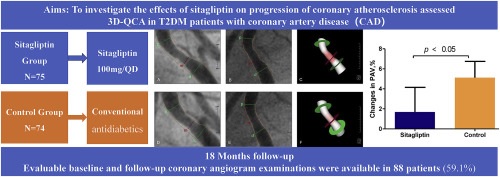Highlights
|

Background and objectives
Type 2 diabetes mellitus (T2DM) is a well-recognized independent risk factor for ASCVD, the aim of this study was to investigate the effects of a dipeptidyl peptidase-4 inhibitor, sitagliptin , on preventing the progression of atherosclerosis. coronary artery disease assessed by three-dimensional quantitative coronary angiography (3D-QCA) analysis in T2DM patients with coronary artery disease (CAD).
Methods
This was an 18-month prospective, randomized, dual-center, open-label, endpoint-blinded, controlled study in patients with CAD and T2DM.
A total of 149 patients , who had at least 1 atherosclerotic plaque with 20% to 80% luminal narrowing in a coronary artery, and who had not undergone intervention during clinically indicated coronary angiography or percutaneous coronary intervention, were included. They randomized to the sitagliptin group (n = 74) or control group (n = 75).
Atherosclerosis progression was measured by repeat 3D-QCA examination in 88 patients at the end of the study.
The primary outcome was changes in percent atheroma volume (PAV) from baseline to study completion measured by 3D-QCA.
Secondary outcomes included change in 3D-QCA-derived total atheroma volume (TAV) and late lumen loss (LLL).
Results
The primary outcome of PAV increased by 1.69% (95% CL, −0.8%–4.2%) with sitagliptin and 5.12% (95% CL, 3.49%–6.74%) with conventional treatment (p = 0.023).
The secondary outcome of change in TAV in patients treated with sitagliptin increased from 6.45 mm3 (95% CL, -2.46 to 6.36 mm3) and 9.45 mm3 (95% CL, -4.52 to 10. 14 mm3) with conventional treatment (p = 0.023), however, no significant difference was observed between the groups (p = 0.175).
Patients treated with sitagliptin had similar LLL compared to conventional antidiabetic agents (−0.06, 95% CL, −0.22 to 0.03 vs. −0.08, −0.23 to −0.03 mm , p = 0.689).
Conclusions
In patients with type 2 diabetes and coronary artery disease, sitagliptin treatment resulted in a significantly lower rate of coronary atherosclerosis progression compared with conventional treatment.















